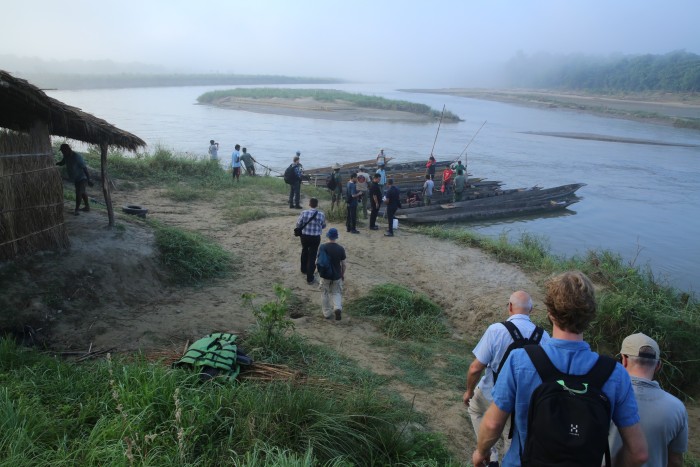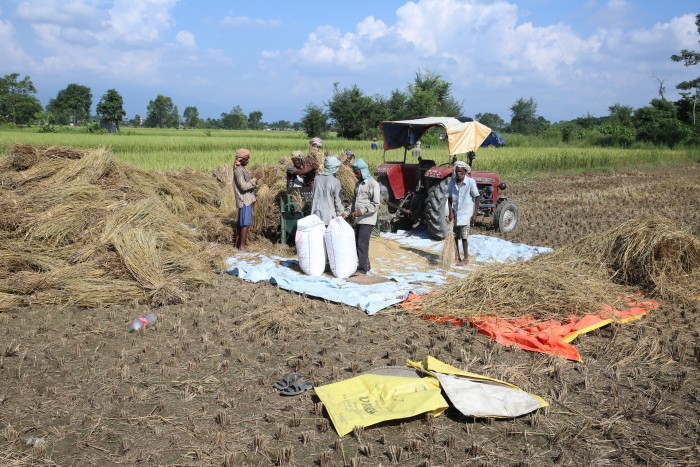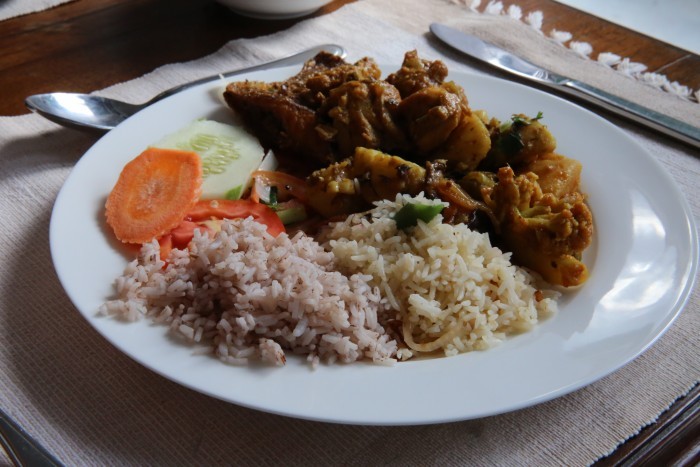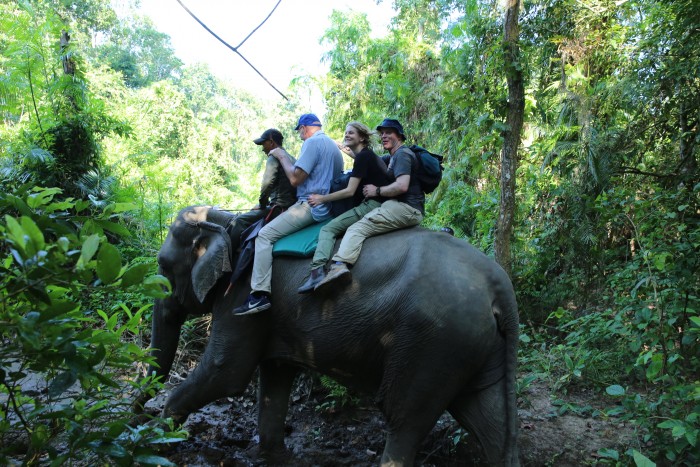Category : Feature Stories
Published : December 4, 2017 - 2:32 PM
An Update from Our Collecting Partners in Nepal
By Chris Cockel, CWR Project Coordinator, RBG Kew. Photos and additional reporting by LM Salazar, Communications Manager, Crop Trust
This is part of a series of stories that we are publishing to highlight the accomplishments of the collecting partners of the Crop Wild Relative (CWR) Project. In October 2017, the Nepal Agricultural Research Council (NARC), who under the CWR Project are collecting wild relatives from gene pools of 16 crops, welcomed CWR Project team members for a visit.
With the sun emerging and the morning mist just beginning to lift, we met our national park guide and boarded canoes hollowed out from single tree trunks, before being punted across the glistening East Rapti River. Excited chatter gave way to a sense of anticipation and apprehension as we were deposited on a sand bank on the opposite side of the river. Greeted by an additional guide: an Asian elephant, her loyal mahout perched on top, we began our trek into the wilderness on foot. This being the territory of the endangered Bengal tiger, the elephant offered a welcome deterrence from possible attack.
We were not here for the elephants or rare one-horned rhinos, and not even for the elusive Bengal tiger, we were on the hunt for a wild rice: Oryza officinalis.
I knew, from past experience, that as it happens in any collecting effort in the subtropics, we would be struggling with the heat, dust, sweat, and potential danger from wild animals – including in this instance blood-sucking leeches dropping from tree branches. It is with a combination of in-country knowledge and expertise, together with a seed collecting guide provided as part of the CWR project, that the seed collectors locate their prize.
We as outsiders were only here briefly, and felt privileged to be taken directly to the best populations of wild rice, but of course, this was not the first time that our colleagues from NARC had visited the Park.
Before collecting, one needs to locate the populations of these wild relatives. And once found, one needs to collect the seeds at just the time, otherwise the seeds will be useless for research or regeneration. Additionally, collectors need permission to gather these vital plant genetic resources – be it collecting from farmers’ fields or protected areas such as a national park.
Seed collecting is rarely as simple as just collecting from a single plant located conveniently next to a main road. It involves months, and in many cases, years of planning to know where and when to collect, and finding sufficient individuals of a certain species, bearing sufficient fruit, containing sufficient seeds when you’re there.
On the trail of wild rice
Our Nepal adventure had begun a day earlier, in the bustling capital, Kathmandu, where we’d been treated to a visit to the National Agriculture Genetic Resources Centre, located a bumpy, dusty half hour drive away from the city centre. The facility includes seed cleaning and processing laboratories, and two spacious new minus 20-degree cold rooms that became operational in 2014 and have space for up to 100,000 seed accessions.
The focus of NARC’s crop research is to conserve agricultural genetic resources, to study endangered, rare and unique genetic resources through morphological and molecular characterization, and to develop elite lines through molecular methods for pre-breeding. Since joining the project in 2015, the collection and conservation of crop wild relatives has been added to NARC’s priorities.
After a frustrating delay at Kathmandu’s sweltering domestic airport terminal, we boarded a Buddha Airlines 50-seater turbo-prop plane and flew the 20 minutes to the south-central town of Bharatpur in Chitwan District.
Rice and food security in Nepal
Rice is a critical component of the Nepalese diet. Many people in Nepal devote their lives to cultivating rice to survive, both rain-fed lowland and irrigated rice varieties, but the country frequently suffers extreme weather events, such as recent widespread flooding of the southern plains.
While Nepal continues to recover from the effects of a devastating earthquake in April 2015, and with food insecurity in general declining, government statistics indicate that the country still imports rice worth US$200 million every year to make up the shortfall between supply and demand.
But rice is not simply rice, especially in the Asia Pacific region. In Nepal, varieties consumed include Gudgude Marsi, Thauli, Mansara, Anadi, Rajbhog, Krishnabhog, Samundra Pheenz, Phalame, says the Nepali Times. And the genebank at the International Rice Research Institute (IRRI) in the Philippines preserves 1,800 local Nepali rice varieties.
In Nepal, wild rice Oryza rufipogon Griff. is consumed on religious and cultural occasions, such as the Hindu festival of Chhath, and we were fortunate enough not only find it in during the collecting trip, but also to try some at one of our lunches.
But O. rufipogon is not collected for human consumption, because it is difficult to harvest, and is usually only used as animal feed, yet it is believed that O. rufipogon is a likely ancestor of domesticated rice, O. sativa L., that we all eat today.
Consumption of CWR is not common, with some wild relatives, particularly in the Solanaceae family, being poisonous.
For the most part, the importance of CWR is due to the valuable genetic traits that enable them to withstand harsh environmental conditions and to ward off a range of pests and diseases. The process of domestication that our food crops have undergone over millennia to make them edible and palatable has resulted in many of these traits being lost.
The aim of the CWR project is to incorporate such traits into domesticated crops, thus enabling farmers to continue to farm, and for food security to be secured into the future.
* * *
After walking for what seemed like hours, we came across a small military encampment of wooden huts on stilts, crossed a muddy stream with only a narrow and wobbly tree trunk for a bridge, and in a single-file made our way deeper into the park.
In many cases, it is necessary to return again and again before being able to say that sufficient high-quality seeds have been collected and conserved. The timing may not be quite right, or you may have been beaten by animals that like to eat what you’re looking for. It frequently involves travelling to remote locations, often in harsh and hostile conditions for days or weeks at a time, working with local people and negotiating local, and sometimes international politics. And, then there’s the so-called post-harvest handling of the seeds. It’s not enough just to collect the seeds in a bag. They need to be handled correctly to prevent them deteriorating and becoming useless even before they’ve made it back to a local genebank.
However, at this moment such thoughts were far from our minds as we tried not to be distracted by the obvious fact that out there, as we walked a dusty trail surrounded by 8-foot-tall elephant grass (Saccharum ravennae L.), spotting tiger and rhino tracks, we were a little off the top of the food chain.
Shortly we came across a second stream, muddier than the first, and with no convenient tree trunk bridge. With the target population of wild rice tantalizing close on the other side of the stream the group needed to weigh up the options.
It was suggested that we make use of the elephant to get the group across. I literally jumped at the chance and scrambled on board our warm and rather bristly carriage.
I was the fourth (and last) passenger riding the elephant. But seconds after the elephant got to its feet and strode into the mud, the discomfort of the ride made me question my eagerness. Still, with relative ease we made it to dry ground on the other side of the stream and as quickly as it had begun, our elephant ride came to an end.
Though I wasn’t aware of it, the mahout must have given the command to the elephant to lower its back. I felt myself sliding backwards, and not wanting to take anyone with me, and thinking I was only inches from the ground, I allowed myself to slide off the back of the elephant. Unfortunately, I was higher off the ground than I realised, and when my left leg made contact with the uneven ground it buckled at my ankle and knee and I fell to the ground. In pain, I scrambled to safety for fear of being trampled under the elephant’s feet. Due to the intense pain in my leg it was instantly clear to me that I wasn’t going to be walking any further.
Partnership working at its very best
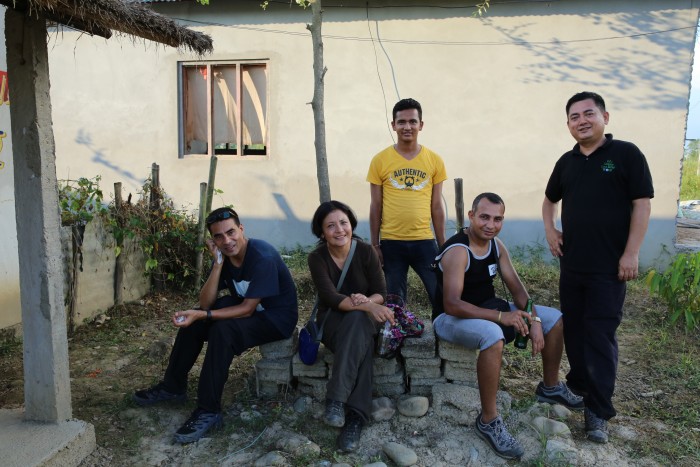
The NARC collecting team, from left to right: Surendra Shrestha, Deepa Singh Shrestha, Suresh Malasi, Santosh Sharma, Krishna Hari Ghimire.
Visiting project partners in their own countries really provides an insight into the issues and challenges that are faced in the field and the effort and commitment involved in making high-quality seed collections.
This is particularly true when in most cases the teams involved in seed collecting are usually made up of no more than half a dozen people, who often have to travel the length and breadth of a country in order to locate genetically diverse populations of a particular species – the real value comes from this genetic diversity contained with different populations of a species that may be subjected to different conditions of climate, altitude, soil composition, and precipitation.
Our Nepalese partners started the seed collecting in the spring of 2016. And they have committed to collecting one of the most diverse suites of taxa among all the CWR partners.
CWR are being collected from the gene pools of 16 crops (alfalfa, apple, banana, barley, carrot, chick pea, cow pea, eggplant, finger millet, grass pea, oat, pearl millet, pigeon pea, rice, sweet potato, and vetch). The complexity of this task means that the Nepalese team must make numerous trips into the field between March and November. And they will be busy into 2018 doing their very best to ensure their ambitious targets for conserving Nepal’s crop wild relatives are met.
So far at the Millennium Seed Bank we have received: Pigeon pea (Cajanus scarabaeoides L.), Carrot (Daucus carota L.), Banana (Musa balbisiana Colla), Sweet potato (Ipomoea cairica L.), Apple (Malus sikkimensis Wenz.), Rice (Oryza meyeriana var. granulata , O. nivara S. D. Sharma & Shastry, O. rufipogon), Pearl millet (Pennisetum orientale Rich.), Eggplant (Solanum virginianum L.), and Cowpea (Vigna nepalensis ).
* * *
While still feeling dizzy from shock, my injured leg now bandaged, I was told that the remainder of the group – frustratingly for me -had located a population of Oryza officinalis on the side of the stream that we had just come from. In pain, I reluctantly struggled back onto the elephant, this time clinging onto the mahout for dear life, and headed back across the muddy stream to be reunited with the rest of the group.
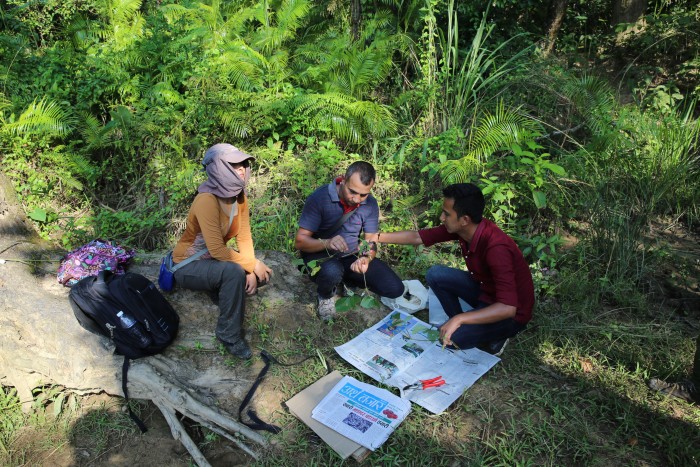
At Chitwan National Park, Deepa Singh Shrestha, Santosh Sharma and Suresh Malasi, prepares a herbarium specimen of O. officinalis.
I was just in time to see our colleagues from NARC nicely demonstrating how to make a herbarium voucher and complete the essential field data forms. The NARC team will come back in a few weeks time, once the seeds are ready for collecting . Repeating visits is not unusual when collecting. Even if the time is not quite right to collect good-quality seed, the collection of phenological data and herbarium specimens is always valuable. Data collection may appear as secondary to seed collecting, but the seeds are useless without good record keeping and documentation, including herbarium specimens.
More than wild rice
The team found Oryza meyeriana var. granulata at Chitrasen forest in the buffer zone of Chitwan National Park, O. rufipogon at Ajingara Lake, and O. nivara by the side of the road at Rupandehi, where it is threatened by aquaculture and urbanization.
But wild rice was not the only thing we were hunting for in Nepal. During the few days, crisscrossing the country, we saw many more CWR, including rice, okra and eggplant wild relatives.
Nepal at a geographical crossroads
Due to its geographic position, and altitudinal variation from high Himalayas to lowland plains, Nepal is a diversity hotspot at a transition zone between six floristic regions. Nepal is slightly smaller than the US state of Illinois at 147,181 km², and makes up 0.09% of the global land mass, but contains a disproportionately large diversity of plants and animals, with an estimated 300 plants that are endemic to the country.
Yet pressures from habitat destruction, human population growth, tourism, pollution, non-native species, genetic erosion, urbanization, infrastructure development and climate change are putting this unique biodiversity, including crop wild relatives, at risk.
We saw this human pressure for ourselves on the way to our next destination, Pokhara, when we stopped at the lake Prabash Taal, close to the hilltop town of Tansen. This once beautiful lake is now sadly polluted by sewage runoff from a newly constructed medical school, putting the survival of wild rice in jeopardy.
CWR Project- leading & supporting a global effort
Collecting CWR is not like collecting crop diversity in farmers’ fields, you need to know what you are looking for, and where to look for them.
A key part of the Crop Wild Relatives project is the capacity building element that endeavours to equip all project partner organisations with the necessary skills needed to collect and store seed. For example, in 2015 and 2016 Deepa Singh, the project coordinator at NARC in Nepal was able to attend the annual Seed Conservation Techniques course and a technical training course at the Millennium Seed Bank, where she joined colleagues from Armenia, Azerbaijan, Cyprus, Georgia, Italy, Malaysia, Nigeria, Peru, Spain and Sudan. Her colleagues, Krishna Hari Ghimire and Bal Krishna Joshi also participated last year in a week-long training course offered at the Malaysian Agricultural Research and Development Institute (MARDI), where partners from Pakistan and Vietnam also participated.
The CWR team in Nepal are committed to achieving their seed collecting targets. Indeed, in Nepal, as in other CWR partner countries, seed collecting teams strive to meet their ambitious targets and contribute, on behalf of their country, to this global effort to capture CWR genetic diversity.
To support our partners, the CWR Project has created a Seed Collecting Guide for each partner country. These guides include distribution maps that indicate where there are gaps in existing collections, photographs and illustrations of target species at different life stages, the threat status of each species and details of flowering and fruiting time to enable seed collectors to harvest the seed at the optimum time, which is at the point of natural dispersal.
Visiting each of our 24 collecting partners is an essential part of the project, to offer them support, follow-up on their progress, and better understand the many complex challenges they face in trying to deliver the seed collecting targets.
* * *
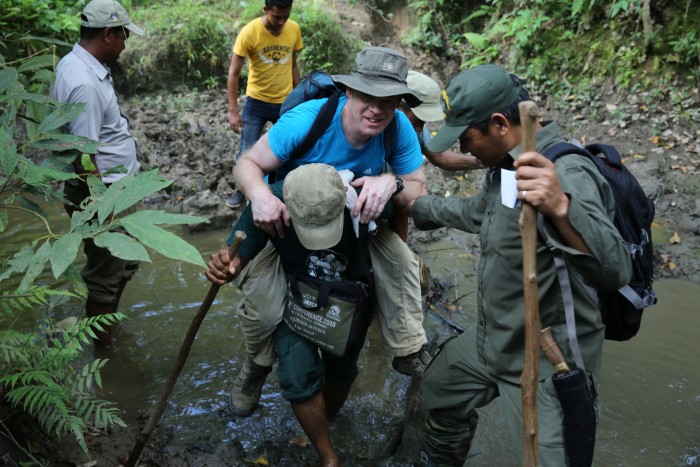
After the fall: national park ranger heroically carries Chris Cockel across a stream in the park’s buffer zone.
Despite the pain in my knee and a visit the next day to a small local hospital I didn’t let this mishap spoil Nepal for me. We still had four more days of field activities, including hunting for different populations of O. rufipogon, O. nivara and O. granulata. And I was able to participate in almost all of the subsequent activities, even rather painfully on crutches.
Such field trips also allow the opportunity, where needed, to work through any issues, provide advice on collecting techniques and best practice post-harvest handling to ensure seed survival, and to help project partners achieve their specific goals.
The inspiration for CWR plus
It’s wonderful to see that the CWR project has inspired NARC to collect additional CWR in the country, such as wild relatives of amaranthus, buckwheat, okra, peach, pear, plum, strawberry and walnut. This rich diversity of CWR to be found in Nepal goes to show what an important conservation partner the country is in the project, and will continue to be as we all strive to ensure the survival of these plants in the wild and in ex situ collections.
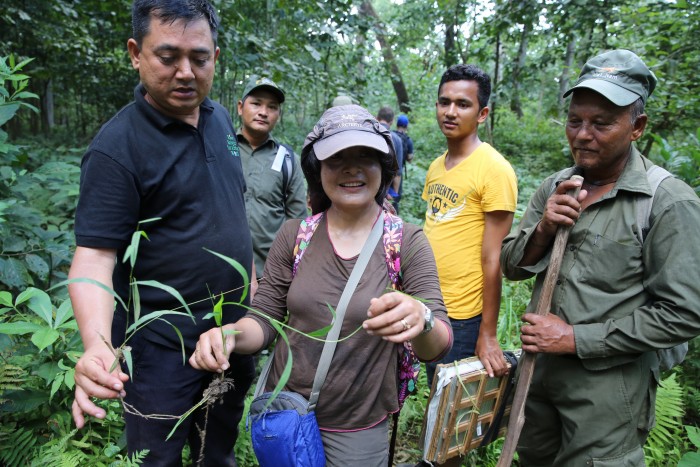
NARC senior scientists Deepa Singh Shrestha (centre) and Krishna Hari Ghimire (left) find Oryza meyeriana var. granulata in Chitrasen Forest in the buffer zone of Chitwan National Park.
This type of international project also demonstrates how national partners can be inspired to the extent that the conservation of a group of plants, such as crop wild relatives, becomes the priority that it wasn’t previously.
Although one week is far too short to really appreciate the wonderful floristic diversity of Nepal, it was a fantastic opportunity to spend time with the team from NARC, experience some of the country’s beautiful landscapes, and gain an ”insider’s” understanding of the challenges that the team faces on an everyday basis to conserve Nepal’s crop wild relatives. Heartfelt thanks must go to Deepa and her team, and we wish them all the best for future seed collecting expeditions.
I continue to think about those Bengal tigers in Chitwan National Park. We did not get to see them, perhaps thankfully, but I know they are there, and just by being there, they are keeping us humans at bay, protecting this truly wild refuge, and indirectly safeguarding the many crop wild relatives to be found there, including Oryza officinalis.
— END —
The Crop Wild Relatives Project is a global effort that aims to collect, conserve, and initiate the use of the wild relatives of crops. It is funded by the Norwegian government and managed by the Crop Trust in partnership with the Millennium Seed Bank (MSB) of the Royal Botanic Gardens, Kew.
All material collected under the Crop Wild Relatives project is shared under the terms of the Standard Material Transfer Agreement (SMTA) within the framework of the multi-lateral system of the International Treaty for Plant Genetic Resources for Food and Agriculture (ITPGRFA).
